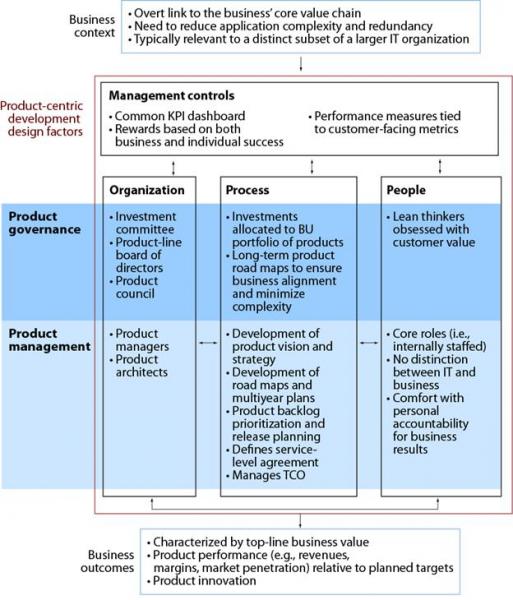What Are The Benefits Of Running Your Software Organization As A Business That Delivers Products?
In my blog post yesterday, I asked whether you should be running your software organization as a business that delivers products. Today I will explore what it means for you to take this approach.
As Forrester has pointed out in past research, to move forward in a product-centric way, you must establish a number of capabilities in your organization in a product-centric operating model:

I used to make a living doing product management and running product management organizations, as did a number of people at Forrester. My perspective on product management is somewhat distinct because I started out on the product engineering side, leading product development organizations. But between my first ISV and my second, I saw the contrast between weak, ineffective product management and strong, effective product management. When strong product management is in balance with an effective engineering group, well aligned, it’s a beautiful thing to see. The weak option? You don’t want to know – it was too painful to remember.
Product management is new to many enterprise software development organizations, but there are a lot of people out there who know how to do it. One of the places I used to find strong product manager talent was GE – it pretty much invented product management, although some might disagree. Getting into the finer points of doing great product management would be beyond the scope of a blog post, but when you have it, here are some of the things that will go right – or at least better – in your ability to deliver great software:
- You won’t waste money on the wrong features. Product managers balance investments in four areas: features that advance their product vision, features customers ask for, features required to respond to a competitor, and investments to retire technical debt. This balancing act will differ with each release cycle – each release may emphasize one area more than another. But when a good product manager correctly balances these priorities over several releases, constantly monitoring customer feedback and market conditions for intelligence, it’s the most efficient way to turn your investment into profits.
- You won’t build the wrong product. Engineering teams working without the benefit of strong product management tend to build products they would want to use, but if your engineers are not like your customers, this often turns out to be a product nobody wants. Product managers know how to work with designers and engineers to deliver the features customers want.
- You’ll be better able to rationalize your app portfolio. One of our clients told us that after they moved to a product-centric model, the business execs who owned each product P&L immediately started asking why they had so many redundant apps that did pretty much the same things. The answer? Before the reorg, there were midlevel execs who defended those redundant apps because they were their apps – but they were not truly accountable for the full cost of that decision.
- You’ll know when to hold ‘em and when to fold ‘em. One of the most important functions of product-line managers (the product manager’s boss) is to carefully track the financial performance of all the products in the portfolio under their control for signs that it’s time to exit the market, sell off the product, or even just move it into a low-cost maintenance mode.
- You’ll be better able to make a business case for investment. With the benefit of a product P&L, you can more clearly show the relationship between investments and profits, including longer-term investments such as retiring technical debt. Of course it’s never easy to convince your backer to pay for invisible features, but in a product-centric organization, you have more ammo.
So are you struggling with issues like these? Are you trying to live in the age of the customer while delivering software in the old way? Then maybe it’s time for you to move toward a product-centric operating model, at least for those parts of your business that work that way (the core, not the context). Forrester can help you figure this out, and we can help you implement your operating model. We have been delivering workshops for clients to help them understand how to do this, and we can do it for you. If you’re a Forrester client, just submit an inquiry in the normal way, and ask for me – I’ll connect you with the right people on our team.
But even if you don’t ask for our help, if this post resonates with you, it’s time to get product-centric!